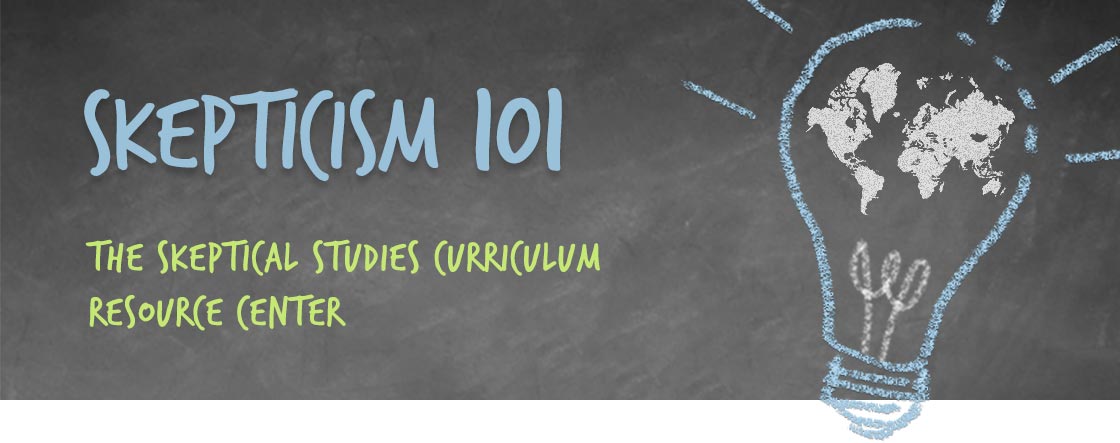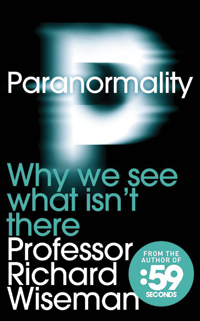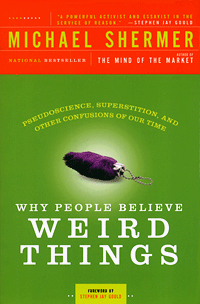You Are Browsing Resources on:
near-death and out-of-body experiences
This book was required reading for “Why We Believe Weird Things: Science and Pseudoscience in Psychology” taught by Dr. Jeffrey Brookings and for “Parapsychology & the Occult” taught by Dr. Terence Hines.
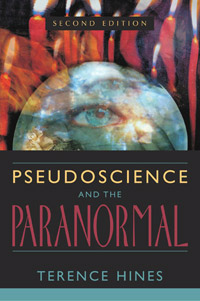
Popular culture fills the mind with a steady diet of fantasy, from tales of UFO landings and alien abductions, haunted houses, and communication with the dead to claims of miraculous cures by spiritual healers and breakthrough treatments in ‘alternative’ medicine. The paranormal – and the pseudoscience that attempts to validate it – is so ubiquitous that many people lose sight of the distinction between the real and the imaginary, and some never learn to make the distinction in the first place. In this updated and expanded edition of “Pseudoscience and the Paranormal”, the most comprehensive and up-to-date work of its kind, psychologist and neuroscientist Terence Hines explores the question of evidence for the paranormal and delves beyond it to one that is even more puzzling: Why do people continue to believe in the reality of the supernatural despite overwhelming evidence that it does not exist? Devoting separate chapters to psychics, life after death, parapsychology, astrology, UFOs, faith healing, alternative medicine, and many other topics, Hines examines the empirical evidence supporting these popular paranormal and pseudoscientific claims. New to this edition are extended sections on psychoanalysis and pseudopsychologies, especially recovered memory therapy, satanic ritual abuse, and facilitated communication. Also included are new chapters on ‘alternative’ medicine and environmental pseudoscience. Critiquing the whole range of current paranormal claims, this carefully researched, thorough review of pseudoscience and the paranormal in contemporary life shows readers how to carefully evaluate such claims in terms of scientific evidence. This scholarly yet readable volume is an invaluable reference work for students and general readers alike. —Amazon
BUY THIS BOOK
from Amazon
This book was required reading for the following courses: (1) “Science, Skepticism & Weird Behavior” taught by Bryan Lovelace, (2) “Skepticism & the Scientific Worldview” taught by Travis Knowles, (3) “Skepticism, Science & the Paranormal” taught by Martin Brigdstock, and (4) “The Scientific Method: Critical & Creative Thinking” taught by Stephen Sekula et al.
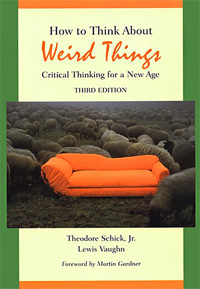
This brief text helps students to think critically, using examples from the weird claims and beliefs that abound in our culture to demonstrate the sound evaluation of any claim. It explains step-by-step how to sort through reasons, evaluate evidence, and tell when a claim (no matter how strange) is likely to be true. The emphasis is neither on debunking nor on advocating specific assertions, but on explaining principles of critical thinking that enable readers to evaluate claims for themselves. The authors focus on types of logical arguments and proofs, making How to Think about Weird Things a versatile supplement for logic, critical thinking, philosophy of science, or any other science appreciation courses.—Amazon
James Randi calls this textbook, “the most powerful, comprehensive, and readable collections of examples, explanations and caveats that I could have ever hoped for.” A library must!—Skeptic
BUY THIS BOOK
from Amazon
This book was required reading for Dr. Michael Shermer’s course, “Skepticism 101: How to Think Like a Scientist (Without Being a Geek)” taught at Chapman University during the fall 2011 semester.
“People are emotionally drawn to the supernatural. They actively want weird, spooky things to be true … Wiseman shows us a higher joy as he deftly skewers the paranormal charlatans, blows away the psychic fog and lets in the clear light of reason.”—Richard Dawkins
Richard Wiseman is clear about one thing: paranormal phenomena don’t exist. But in the same way that the science of space travel transforms our everyday lives, so research into telepathy, fortune-telling and out-of-body experiences produces remarkable insights into our brains, behaviour and beliefs. Paranormality embarks on a wild ghost chase into this new science of the supernatural and is packed with activities that allow you to experience the impossible. So throw away your crystals, ditch your lucky charms and cancel your subscription to Reincarnation Weekly. It is time to discover the real secrets of the paranormal. Learn how to control your dreams—and leave your body behind. Convince complete strangers that you know all about them. Unleash the power of your unconscious mind. —Amazon
BUY THIS BOOK
from Amazon
This book was required reading for the following courses: (1) “Skepticism 101: How to Think Like a Scientist Without Being a Geek” taught by Michael Shermer, (2) “Weird Science” taught by John Donovan, and (3) “Skepticism, Science, & the Paranormal” taught by Martin Bridgstock.
In this age of scientific enlightenment, many people still believe in mind reading, past-life regression theory, New Age hokum, and alien abduction. A no-holds-barred assault on popular superstitions and prejudices, Why People Believe Weird Things debunks these nonsensical claims and explores the very human reasons people find otherworldly phenomena, conspiracy theories, and cults so appealing. Michael Shermer takes on science luminaries like physicist Frank Tippler and others, who hide their spiritual beliefs behind the trappings of science.
Shermer, science historian and true crusader, also reveals the more dangerous side of such illogical thinking, including Holocaust denial, the recovered-memory movement, the satanic ritual abuse scare, and other modern crazes. Why People Believe Weird Things is an eye-opening resource for the most gullible among us and those who want to protect them.
BUY THIS BOOK
from Shop Skeptic
This course was taught at Southern Methodist University.
Excerpt from Syllabus
This course will provide students with an understanding of the scientific method sufficient to detect pseudoscience in its many guises: paranormal phenomena, free-energy devices, alternative medicine, intelligent design creationism, and many others. Students will learn to think critically and to question outlandish claims, hype, and outright BS. Students’ writing will improve and they will be able to distinguish credible sources of information from nonsense; students will become intelligent consumers of information. Students should expect to do a lot of reading, writing, and, most of all, thinking.
DOWNLOAD THIS RESOURCE
(377 kb PDF)
This course was taught at Davis & Elkins College during the spring 2010 semester.
Excerpt from Syllabus
This course exposes students to ongoing biological research. Published articles from scientific magazines and peer-reviewed journals will be thoroughly analyzed and discussed. As part of the course, students will be invited to watch selected episodes of Penn & Teller’s Showtime TV series “Bullshit,” which exposes and debunks pseudoscientific claims and paranormal phenomena.
Learning Goals
By the end of this course, students will be able to:
- Interpret scientific data, as presented in the literature.
- Determine whether authors’ conclusions are valid, based on the available data.
- Suggest follow-up studies to address weaknesses in current research.
- Recognize the difference between science and pseudoscience.
DOWNLOAD THIS RESOURCE
(194 kb PDF)

